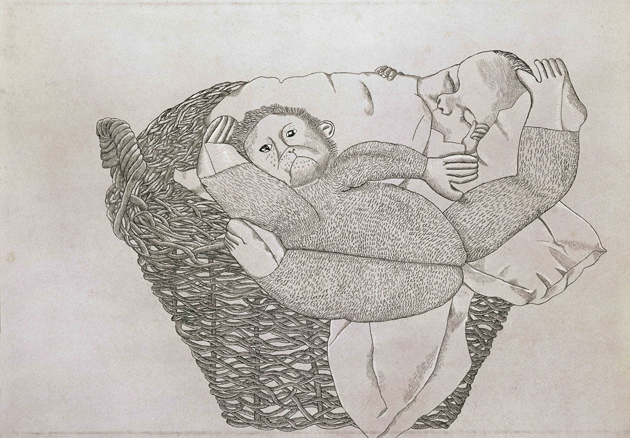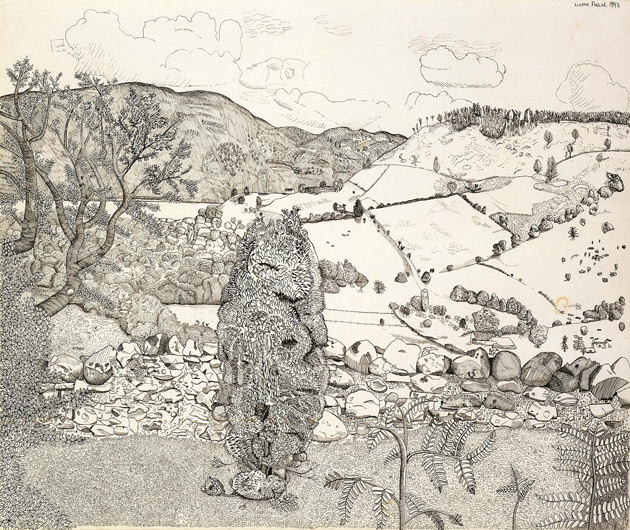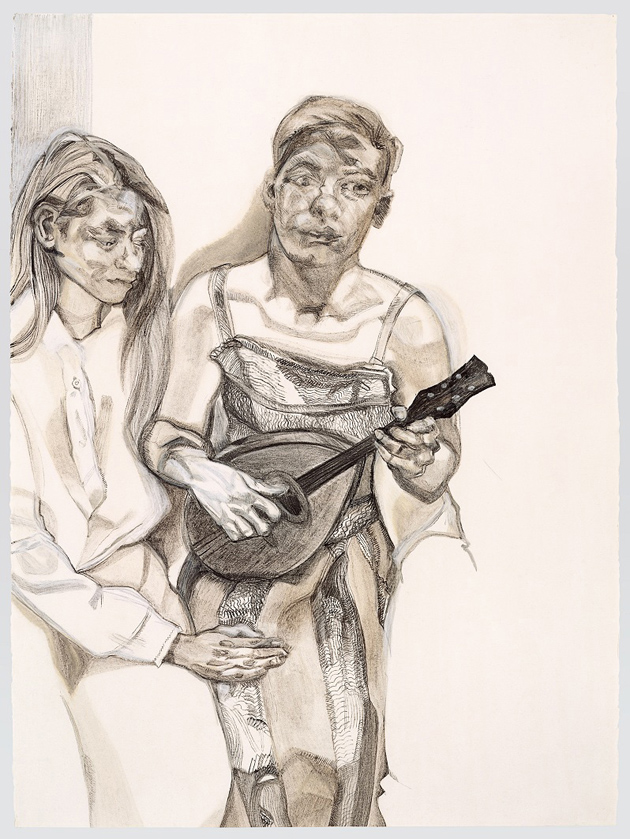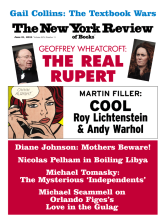It isn’t altogether news that the realist painter Lucian Freud, who died last July at eighty-eight, was something of a child prodigy—and was certainly a disciplined, adventurous, and ambitious artist already by his early twenties. At the current exhibition “Lucian Freud Drawings,” though, the variety, peculiarity, and technical mastery of his work from the 1940s, when he was in his twenties, may strike viewers as a gift from out of the blue. We follow a young artist who, while capable of tossing off charming doodles of friends and fantasy creatures, or making a brilliant caricatural sketch of a donkey named Tommy, was mostly concerned with delineating his subjects as precisely as possible. And perhaps as a byproduct of his seemingly obsessive need to be so accurate, many of his highly finished drawings are touched with odd or fanciful notes.
His subject might be, a little strangely, a dead monkey, which he brought home as a subject to study (this happened more than once). Or he could draw, amusingly and unexpectedly, a sleeping baby accompanied by a stuffed monkey, which eyes us with suspicion. In a stunning 1943 landscape entitled Loch Ness from Drumnadrochit, Freud barely gives us a glimpse of the famous loch, but he accounts for seemingly every leaf and pebble in the terrain. In his often spectacular portraits, which brought out the most in him, we face young male sitters who sometimes have a distinct sensual allure and young women who can express an unusual degree of apprehensiveness. Yet Freud draws facial features in such exaggerated ways that these pictures can seem cartoonish, or overly stylized, even inept, at the same time as they are spellbinding.
Freud’s early art has been linked to Surrealism, a vein of which, in those years, emphasized such an acute, sharp-focused realism. There was also an interest at the time in the awkward, stiff simplicities of folk art, and Freud, like a folk artist—or like an artist who is reluctant to give up the approaches that worked for him when he was very young—often seems to operate as if his portrait subjects’ eyes and lips (and possibly ears) are the only elements in a face that really count. Yet the best of his early drawings don’t come across as remnants of one period style or another. They are still bracing. They would hold our attention even if they were all Freud did.
“Lucian Freud Drawings,” which was assembled by the critic William Feaver, who has written extensively about the artist and planned out the show with him in the years before his death, covers far more than the 1940s. It goes from a picture of birds made when Freud was eight to a chalk drawing of a man’s head and shoulders from last year. Including examples of the painter’s ink, pencil, conté crayon, watercolor, and charcoal drawings, with a nod to the etchings he began doing in number from the 1980s onward, it gives an inviting and somewhat informal overview of his entire working life. It appealingly intersperses relevant small paintings among the works on paper, and it is accompanied by a handsomely produced, album-like catalog.
The exhibition and catalog also help remind us of a more vibrant, dramatizing artist than the Freud we have been familiar with in the past few decades. Not that his art became, over the years, radically different. On some level, the English painter’s work remained remarkably consistent all the way through. Freud is now internationally known for his portraits and his images of often naked sitters, who are generally found sleeping, or staring off while seated on some ratty sofa, in the artist’s bare and rough-hewn London studio. And in one way or another he made pictures like these, in which he recorded as scrupulously as he could what was before his eyes, from the late 1940s on.
Freud was a romantic. He was after an emotional truth, which he saw in unadorned, often blemished, nearest-to-hand facts. If a sitter had blotchy skin, or if what Freud saw outside his studio window was weeds, banal buildings, a dull sky, and piles of garbage, there was a moral urgency in pinning down these details. Part of his achievement was to show how this quest—a quest that, seen against the history of twentieth-century art, initially struck many as superannuated—could result in pertinent, forceful pictures.
Freud kept on rethinking the formal possibilities of his brand of realism, and that is greatly to his credit as well. He could have stayed what he was in the 1940s: a razor-sharp perfectionist, a creator of portraits, including self-portraits (a few are in Feaver’s show), that practically buzz with a sense of anxiety. Around 1950, though, he began to make his art, in an emotional sense, less febrile and ostensibly more grounded. Instead of showing his sitters as characters in some tense drama that was already underway, he began to present them as unguarded people who apparently had settled, in one of the dilapidated pieces of furniture in Freud’s studio, into whatever mental state they wanted to be in. He was saying that there was no larger story being told.
In a technical sense, Freud’s work changed correspondingly. His handling of paint became looser, broader, brushier. His friend Francis Bacon, seen in the current show in two fluid drawings where he seems to be losing his pants, was instrumental in getting him to go in this direction by using softer, bigger brushes. Freud’s color became earthier as well—literally so. Has any artist been so wedded to brown, tan, ivory, and orangy reds?
Yet he hardly relinquished his terrific sense of design. In Freud’s most gripping pictures from roughly the 1950s through the 1970s (during which he remained little known beyond his English audience), his sitters appear to have been caught casually. Freud’s chosen image seems to derive from merely the angle at which he has looked at them. We are usually made aware, though, of the image as a compressed, four-sided entity. There is a real pleasure in seeing and feeling how each element in it—the sitter’s face, the wood floor, the leather chair, the plaster wall—has both its own juicy or granulated surface texture and locks into place, like gears in a machine, with the other elements.
At some point in the late 1980s, however, when Freud began to make quite large paintings, the formal tension in his work got lost. It was, of course, remarkable that, in his seventies and eighties, he was testing himself for the first time with huge canvases. But the pictures, I think, are a little numbing, even bombastic. He now sometimes used models who, seen in the nude and mountainously fleshy to begin with, gave the pictures the quality of being showcases for what felt like a kind of gratuitous freakiness. There is at this point a generation of art students and museumgoers who think of Freud as being summed up by these large, portentous, and often reproduced works. It is this audience in particular that needs to see the devilishly playful artist he was in his early days.
The current exhibition, it should be said, could be made even finer, at least for its crucial period, the work from the 1940s. (Freud’s drawings from after this time don’t have an electric force. They are sketchier, more adjuncts to his painting.) Sebastian Smee’s volume Lucian Freud on Paper (2009), for instance, gives a fuller idea of how rich Freud’s pictures of people were when he was in his twenties. It would have been wonderful if the Acquavella show could have included the 1948 conté portrait of the bearded painter and set designer Christian Bérard, seen in his terry cloth robe. This breathing, amazingly textured work could be set beside the great drawings of any era.
Missing as well are Freud’s finest conté drawings from the same time of his first wife, Kitty Garman. His images of the large-eyed and intently watchful brunette sometimes are merely melodramatic. But in other examples (which didn’t make it to the present exhibition) her look of dread blends in with her appearance as a beautiful young woman. And Smee’s volume amplifies what is suggested in Feaver’s exhibition: that before Kitty, Freud’s most striking portraits were of boys and young men—and that these works, in which we are very aware of the sitters’ lips and eyelashes, can feel (at least to this viewer) sexual in nature.
But then the current show includes an astounding picture that I don’t believe has appeared in any of the numerous books on the painter that have come out in the past two decades. It is Man and Town, a primarily ink drawing, dated 1940–1941, when Freud was about eighteen, of a man standing close to us, with a seemingly endless, storybook town (or, really, world) behind him. No more than about a foot on a side yet vast in feeling when you stand before it, the picture conveys a sense of an artist exercising an awesome degree of control, and energy, as he draws, in outline form, house after house, and goes on to account for seemingly every street and, incredibly, window. Freud came to feel that it was enough to show sitters in a small room. But his best work suggests, at least metaphorically, a much bigger stage, and in his teenage drawing he spells out what he had in mind.
Advertisement
This Issue
June 21, 2012
Real Cool
How Texas Messes Up Textbooks
Mothers Beware!






